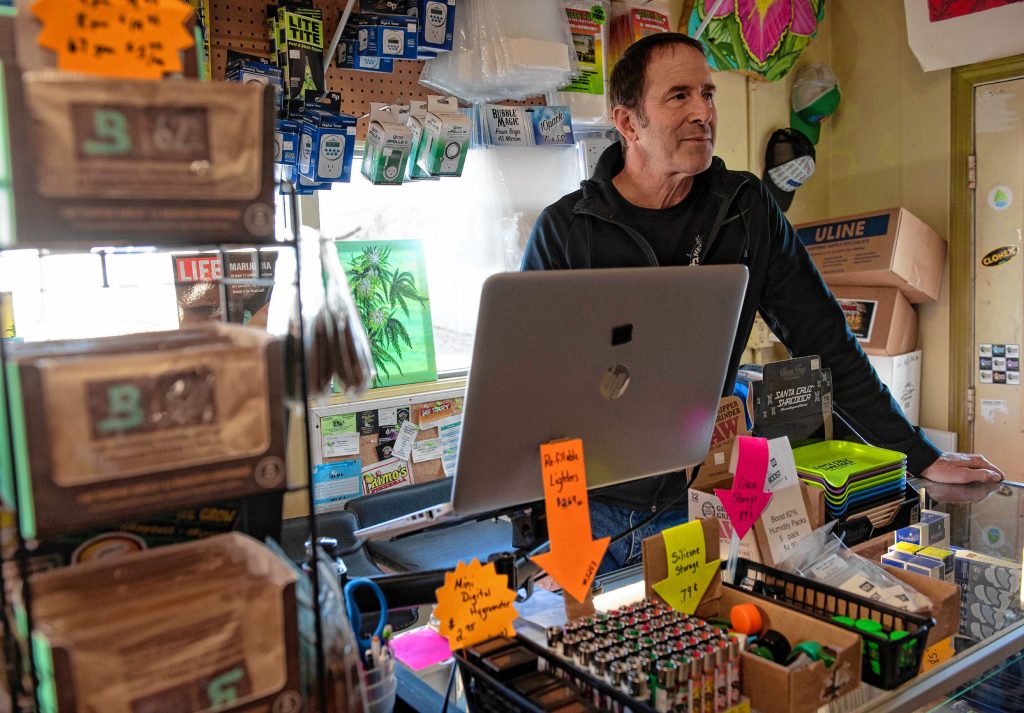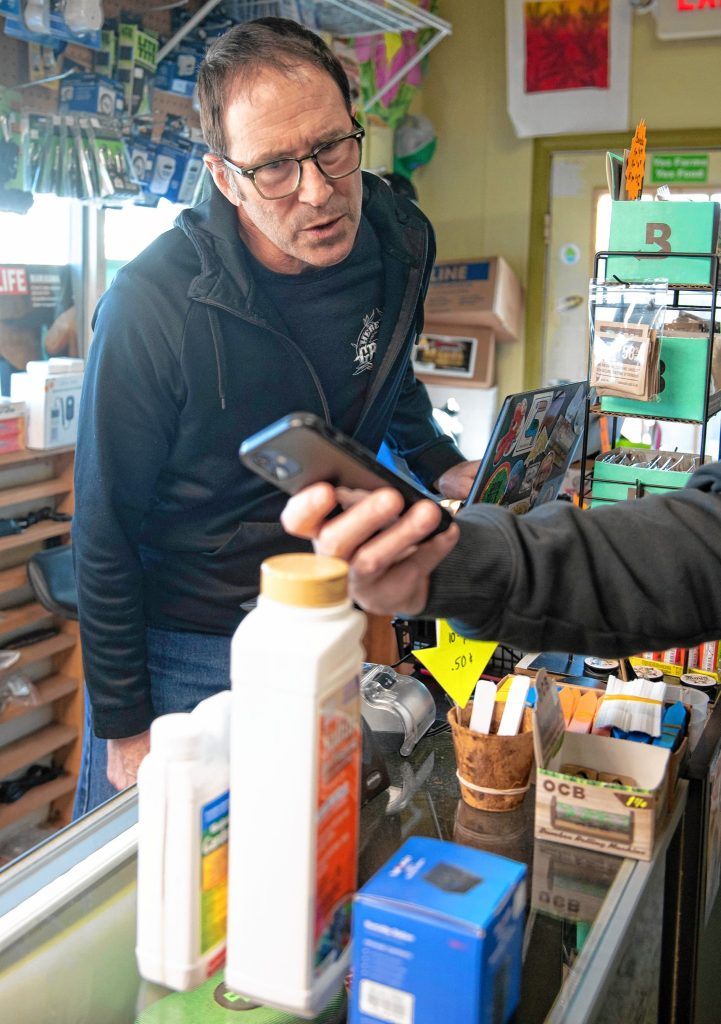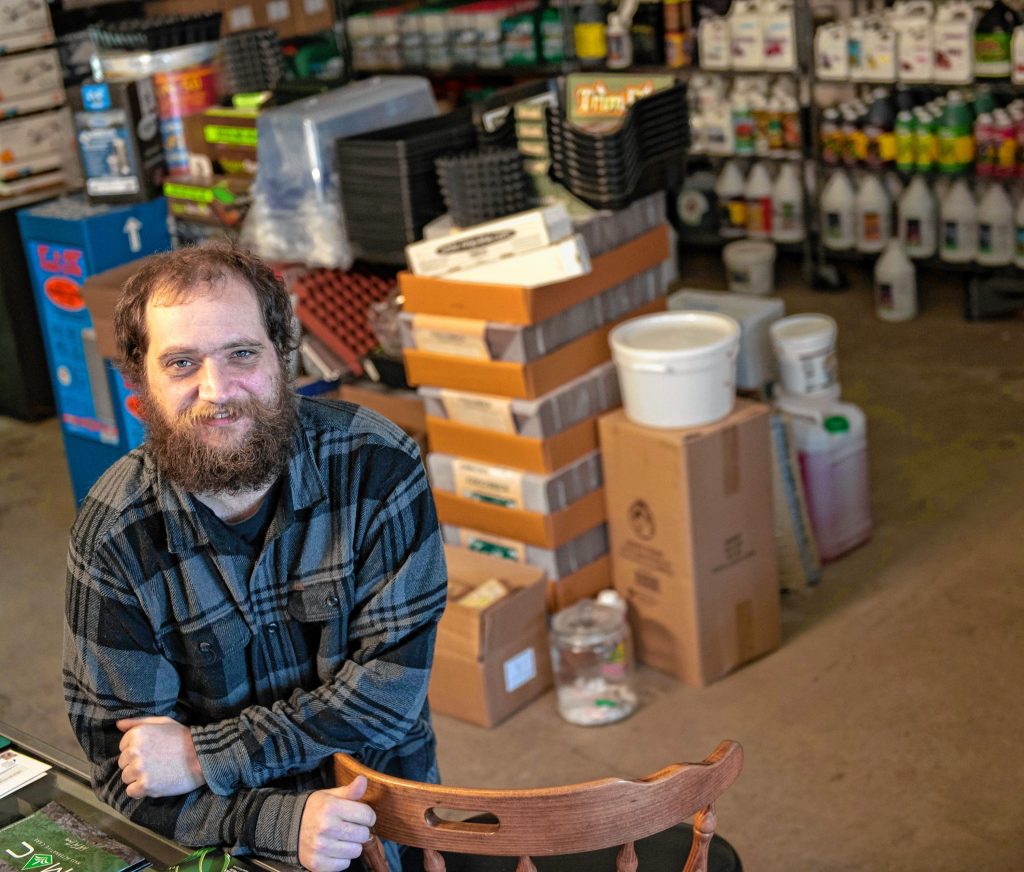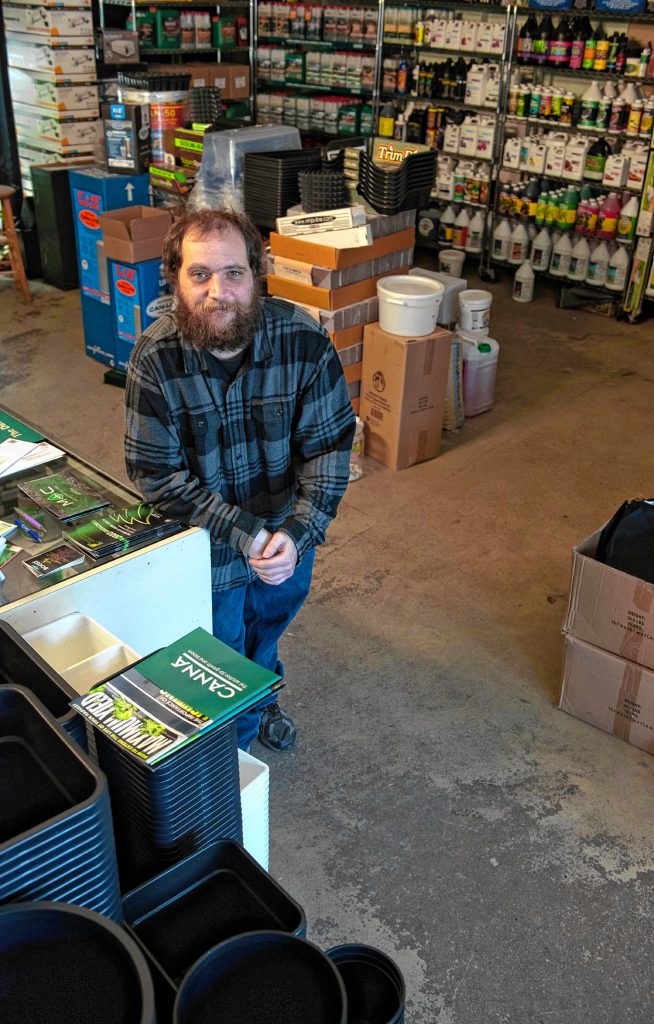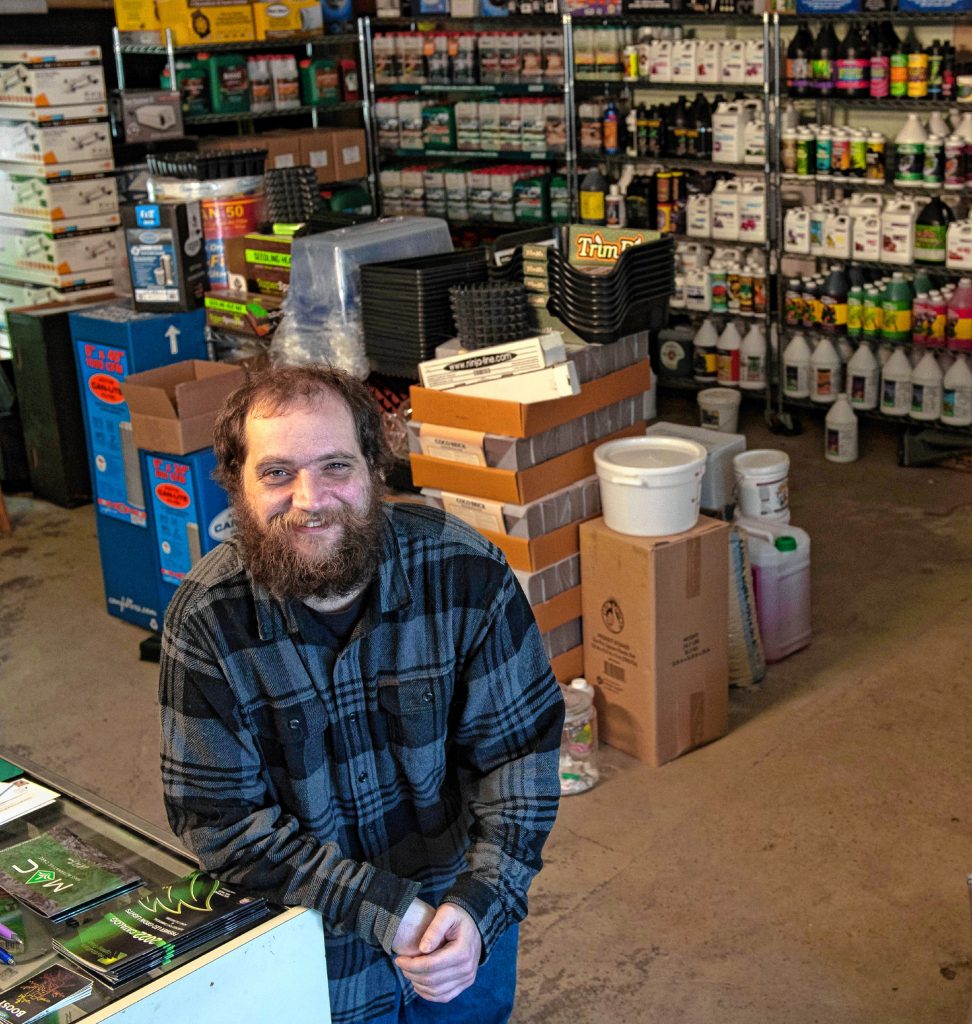As we settle into this brave new world that has us purchasing pot as naturally as picking up doughnuts Sunday morning, there are a lot of people, then and now, who never cared much for the “purchasing” part.
Whether it be at that nice clean dispensary down the street or over at the cousin’s third-floor walk-up with the crying brats and the blaring TV, these folks will have none of it. They are the home growers. They have always been here. And their numbers are growing like, dare we say, weeds.
Yes, the ancient art of growing your stash at home under a brazen array of lights is still very much alive, but these days, since legalization of 2017, more and more small-time growers are taking those 6-12 plants the law allows and sticking them in the ground out back, where they bask in the rays of the real McCoy, growing faster than Jack’s beanstalk, with no evidence-gathering helicopters whirring overhead.
“The whole thing used to be underground,” said owner and longtime home grower Doug Andrews of Hadley’s Here We Grow, a supplier to growers, with all its soil, lights, nutrients, pots, tents and bigger pots. “You had to hide it. Everything had to be inside with lights. People now are realizing ‘I can just plant these plants out in my garden and let the sun do what it does.’”
New England weather? “It’s a crap shoot,” said Andrews, “but a lot of people did very well last year. The industry’s changed a lot, even in the last five years.”
COVID surge
The industry kicked serious ass during Covid. “It blew up. Covid was a boomtown,” said Andrews, “because people were home getting high all day, I guess. We saw a big drop off last fall when people went back to work. Everybody’s penny pinching this year.”
The problem that pains the home grower most? Pests, insects so small you can only see the havoc they wreak. “One of the newer pests is the russet mite,” says Andrews. “Microscopic. So small it rides the wind like pollen — everyone downwind is gonna get russet mites. Pests are shipped across the country. The good news is that there are always ways to control it that’s safe.”
Behind Andrews’ counter: a LIFE magazine from 1969 with the technicolor closeup of a joint (robin’s egg blue, of course) being toked on by the lips of some clean-shaven young person, with just a fleck of daylight in an otherwise windowless scene. The words under the smoker’s foreshortened fingers say: “Marijuana. At least 12 million Americans have tried it. Are the penalties too severe? Should it be legalized?”
Andrews’ estimate of the number of Americans using weed today? “At least half the population,” he grinned.
“When (President) Carter was in it was suggested but went the other way,” said Andrews. Just say no, with the muscle of law enforcement behind it, became the law of the land.
(Another LIFE cover that same month features the striking perfection of model Naomi Sims, under the headline: Black Models Take Center Stage. There are numerous themes of 1969 that would have done well to continue but it takes awhile, sometimes, for people to catch up.)
Stores that sold supplies to home growers came under siege during the war on drugs with Operation Green Merchant, a nationwide DEA operation targeting businesses advertising the sort of horticultural equipment that could conceivably be used to grow cannabis.
The goal was to shut down the rising indoor marijuana industry, by tracing deliveries of indoor growing equipment and seeds.
“The same fertilizer you’d use to grow vegetables and flowers,” says Andrews. “They were busting people who were also growing orchids and tomatoes.”
“I’ve been a person of interest,” says Tom Wells, 60, who’s owned Liquid Sun in Holyoke for 22 years. “I’ve been growing indoors most of my life. Cops have been to my house, helicopters running IR. I’m sure my file’s like this high. I still get PTSD from it, cops following us, undercover stuff. Now it’s like the day after a thunderstorm, birds are chirping, everybody’s happy, cops are gone.”
Outdoor growing season
In preparation for the outdoor growing season right around the corner, Wells was recently seen forklifting a ton and a half of Groundswell fertilizer off a tractor trailer parked outside his business.
“I was an electrical engineer by trade, until that industry fell apart,” says Wells, “when they saw that kindergarteners could master computers.”
So why not get into something he was good at — cannabis. “I’ve been a consumer for a long time, beginning in the 1970s, finding some seeds and growing them. I’d always been a gardener, whether it was tulips at 5 years old, to tomatoes, to Concord grape vines.”
“It’s a hobby,” says Wells. “Ya have to love it, same with vegetables. Should I put my heart and soul into a few tomato plants when I can easily buy them at the farmer’s market? The price of cannabis has come way down.”
Even though places like Liquid Sun were known to carry weed-related products, long before even the hint of legalization, conversations at the counter came with a knowing wink. “If you came in talking cannabis five years ago, you gotta go,” says Wells. “Come back tomorrow, I won’t remember you.”
“This hobby dictates that we don’t take names and numbers,” he continues. “You say your last name it goes right through my ears. That way, if a cop comes, ‘that guy who was just in here, what’s his name, what was he buying?’ You just shrug.”
“The people who are putting up the dispensary money are the cops, the lawyers, the same people who we’re saying you were bad,” said Wells. “But they’re gonna lose. Once it goes federal you’re gonna see it in the convenience store.”
So with expensive lighting systems and the heart-stopping electrical bills, many growers are opting for something else, reducing a store’s profit margin,
“Now it’s fertilizer and soil; lighting has sort of gone by the wayside to a certain degree,” said Wells.
The home growers have become yard growers. “They start this time of year,” said Wells. “They get a florescent light til (the plants) are a couple feet tall and put them in the backyard. But then they torment their neighbors. Pew! Outside you could get a 20-foot plant. If I have a plant in my driveway you can smell it a half-mile away. I won’t grow outdoors for that reason. You gotta be responsible. I wouldn’t want to smell it all day myself. I worked in a donut shop, ONE night. The sweet smell made me sick, and I love donuts. I couldn’t eat a donut for two years.”
“Anyway, the quality is a lot better inside, with a lot less bugs.”
During weed’s prohibition, which lasted 40 years longer than the actual booze Prohibition of the Roaring ’20s, if you grew marijuana outside, a few things were likely to happen: thieves with bolt-cutters, saws and pickup trucks would hack it all down and haul it away, or the plants, now monstrous, would be spotted by copters and you’d soon see bonfires on your property. Now, not so much.
“You could get ripped off but there’s no value in it anymore,” said Wells. “Everybody’s doing it. It’s not worth getting shot over.”
And the lights, meanwhile, will swallow your money in gulps. “National Grid is disgustingly expensive,” said Wells.
Tom Wells’ right-hand man at Liquid Sun is son Justin, 30, who loves coming to work. “You meet interesting people and learn something new every day,” he said. “And marijuana is something that helps people out. We should all do more of this instead of going to doctors.”
Like many during the witch-hunting era, where kids were encouraged to turn in their parents, Wells kept it away from the kids, at least until high school graduation, and indulged in the habit secretly, out by the trees. “Exactly! I stayed in the closet as long as I could. Once they turn 18, different story.”
Justin Wells chuckled. “He tried to keep it from us, but we got the hang of it — what’s that funny smell?”
Tom Wells snorts at the underestimation of the drug’s precarious history. “You’d go south of the Mason Dixon line you were going to jail for possession of weed. And if you have more than 12 (plants) right now they can still kick your door in,” said Wells.
When told that a photographer would be coming, Justin figured he’d better trim the old beard so as not to “look grumpy.”
“Why don’t you have a joint hanging from your mouth?” suggested Dad.
But for all that, Tom Wells says he still enjoys the business. “People are generally OK, but it’s a long time between September and June.”
Experts share advice
Unlike Wells, Here We Grow’s Doug Andrews, meanwhile, was not much of a gardener when he first started growing weed. “I grew up on a farm, I hated growing plants — it’s work! But once I started growing cannabis, I started growing all kinds of plants. I doubt I would have had that skill if not for marijuana.”
“I started growing at 17, ‘cause I didn’t want to pay for it. Back then everything had seeds in it, bag seeds, we called ‘em. And it took off from there.”
As for how he got turned on to grass in the first place? “Older high school girls. I mean, you’re not gonna say no.”
Andrews is used to having his brain picked, by strangers and regulars alike. “I get a lot of enjoyment out of teaching people how to grow,” he said. “Some days it’s almost like a bar in here. There’ll be a whole bunch of regulars and they come in to shoot the shit, just nonstop banter about growing and what you grow. Sometimes the crowd gets so big I had to put a couch back there.”
But plenty of first-timers come through that door, eager to have Andrews tell them what they’re doing right, and, OK, wrong. Gil from Granby, an experienced grower fairly new to the area, bounded in and talked fast, something about pinching off one of the tops and sticking it in a little media. “One batch had a 100% success rate. Tried it again, zero.”
The focus, he surmised, was in the rooting, and he showed Andrews the product he’d been using for that very thing. What followed was a bang-bang back and forth about roots and top-trimming and whether or not Gil is keeping his clones in a dome (sort of a little greenhouse ) and how wet, how dry should clones be — and it could just as well be two tropical fish guys talking about cichlids from Lake Malawi.
“When it gets cold you gotta have a heat source.”
“Like baby chicks.”
“The mothers are healthy because I utilize a fish fertilizer emulsion — you probably sell it.”
“Stinks to high heaven.”
“You don’t want to get any on ya.”
“Lights go on for 15, off for 12.”
“Clones? Leave that light on 24 hours a day, don’t even give ‘em a rest.”
Gil’s mouth hangs open for a beat but then he’s onto the Dark House Method he and his partner have instituted. “At 7p.m. he puts a cover over ‘em.”
“Light deprivation,” nods Andrews.
“Then he simulates fall so the plant thinks it’s time to produce buds … and then at 9 o’clock when it’s really dark, he goes back to take it off, ‘cause you don’t want the thing to suffer, then in the morning when you’re having your second cup of coffee you don’t want to go running out there to take it off.”
“Forget about it,” Andrews agrees. “I know people in the area who get three ‘light-dep’ crops. They get that first crop going in March, then they ‘light-dep’ ‘em.”
One might guess that Gil is someone who sings to his crop. “Sing, no. But guitar, bass, piano? Of course.”
He said in all his years working in a machine shop he never once got high. “You’re cutting metal to a thousandth of an inch. Classic risk and reward. We’re working with cutting tools and if you cut a finger — I’m not so good at the guitar NOW!”
A very tall young man just starting out but with ambition in his eyes came through the door with questions by the dozen. He expects to do the bulk of his growing inside.
In keeping with the no names culture of home-growing, he said, “No thanks. I do appreciate what you’re doing, though, bringing a spotlight to the culture, definitely a long time coming.”
His is not a get-rich-scheme. “I’m thinking a grow that’ll just sustain me enough to not have to purchase it. I’m really into nature. This medicine has helped so many people, it’s helped me, it helps my family members. Rather than go the pharmaceutical route, we take the herb that we already have.”
He gathers prices online. He understands that there are a lot of misleading things to be found online, especially having to do with wattage. “Lot of false advertising with LEDs,” Andrews cautions. The lighting system the two are standing under goes for $799.
The young man envisions growing plants higher than his reach, and the dude’s reach could block hook shots.
Andrews recommends some key reading material and sells him the iconic “Cannabis Growers Handbook,” by Ed Rosenthal.
“What better way to know what I’m getting than creating it myself?” the man asks. “I’m all in for becoming a student.”

